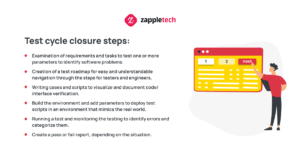The growth of the QA sphere is stable and keeps at the CAGR level of 7%, and according to GMInsights, the value of the testing market will reach $60 billion by 2027. This is driven by the continuous development of the IT industry and the increasing involvement of entrepreneurs in business digitalization. In the current climate of intense competition for user loyalty and market share, greater attention is being paid to the quality of apps and web resources.
As a result, the trend toward thorough testing of IT products during development has firmly established itself as one of the most favored services in the industry. This has received necessary funding, which in turn fuels the growth of the testing sphere and encourages the study of new methods, tools, and training of specialists.
The Test Cycle Closure Report provides a comprehensive summary of the entire testing phase. Include key metrics like test cases executed, passed, failed, and any unresolved defects to give stakeholders a clear overview of the testing outcomes.Sergey AlmyashevCOO, ZappleTech Inc.
Among the many facets of software testing, one critical element that directly impacts the overall efficiency of QA processes is the test closure report in software testing. This report serves as a crucial documentation stage that encapsulates the results of the testing phase, offering insights into what was achieved, what issues remain, and recommendations for future improvements. The test closure report in software testing not only ensures that testing objectives were met but also aids in the continuous refinement of IT products, ultimately contributing to better user experiences and more successful project outcomes.
The topic of testing IT solutions is vast, and while it is impossible to cover everything in one article, today we offer you a brief introduction into the importance and role of the test closure report in software testing. This integral component of QA ensures that projects meet their goals efficiently and is essential for improving product quality in today’s competitive digital landscape.
Table of Contents
What is STLC? Phases of STLC
The Software Testing Life Cycle (STLC) is a comprehensive process that outlines the specific steps involved in testing a software application. It ensures that software is thoroughly evaluated for defects and performs according to the expected standards. The STLC consists of distinct phases, each designed to identify and resolve issues in software functionality, performance, or security.
One of the key documents generated at the end of these phases is the test closure report in software testing. This report captures the final status of testing activities, detailing what has been tested, any unresolved issues, and the overall quality of the product. It also verifies whether the software meets its requirements and is ready for deployment.
Phases of STLC:
Requirement Analysis: In this phase, the testing team reviews the software requirements and identifies what needs to be tested. This phase is crucial for understanding the scope and objectives of the testing process.
Test Planning: Here, a detailed plan is created, outlining the testing strategy, resources, timelines, and tools required. This phase defines the approach to achieve the testing objectives.
Test Case Development: Test cases and test scripts are created based on the software requirements. These cases help ensure that each functionality of the software is tested.
Environment Setup: The environment in which testing will take place is configured. It includes setting up the hardware, software, and network configurations required for testing.
Test Execution: This is where the actual testing takes place. The test cases are executed, and any defects found are logged for further analysis and correction.
Test Closure: In the final phase, testing activities are formally closed. The test closure report in software testing is generated, summarizing the overall testing effort, defects found, lessons learned, and whether the software is ready for release.

Checking Requirements
Before testing starts, a team leader and project manager study the ready-made code fragments and analyze the need for certain checks. This preparation is the basis of the entire testing cycle throughout the sprint, ensuring that the team is aligned with the project’s requirements. Proper documentation, including the test closure report in software testing, becomes essential at this stage. The results of the testing process are used to compare the input and output data, ensuring that all requirements are met before the project moves forward. The test closure report in software testing serves as the final summary, detailing whether all predefined goals and checks were completed successfully, thereby closing the testing phase. Checking requirements and having clear documentation ensures there are no discrepancies between the expected and actual results.
Preparation goals:
- Identification of the types of future tests.
- Matrix development.
- Selection of test environments.
Based on the analysis results, methods, techniques, and testing tools are determined, and executors are selected: testers or engineers.
Creating a Work Plan
Planning goals:
- Determination of the scope of work.
- Appointment of responsible ones.
- Allocation of resources.
As a result, the team understands the tasks set for them to complete in a limited time frame, namely until the end of the sprint.
Development of Test Cases
Development of test cases plays a crucial role in the software testing lifecycle, serving as the foundation for an effective and structured approach. The process begins with the meticulous creation of test cases, instructions, scenarios, and scripts that outline every action necessary to ensure the software functions as intended. Each step in the test case is thoroughly described, highlighting the specific need for each action. This documentation not only helps to track the testing process but also facilitates communication and collaboration within the testing team.
Use the report to document lessons learned from the test cycle, such as process improvements, issues encountered, and areas where the team can improve for future cycles. This helps drive continuous improvement.Mikhail BodnarchukCDO, ZappleTech Inc.
As part of the larger testing strategy, it’s important to recognize the role of a test closure report in software testing. Once the test cases have been executed and the testing phase concludes, the test closure report is created. This report provides an overview of the entire testing cycle, summarizing the results, identifying any open issues, and offering insights into the overall quality of the product. By generating this report, teams can ensure they maintain thorough documentation of what was tested, how it was tested, and the final outcome, closing the loop in the software testing process.
Purposes of creating cases:
- Organization of test cases.
- Prioritization of tests by importance.
- Optimization of the finding bugs.
Consequently, performers receive a step-by-step guide to test functions, code, or interfaces. Also, at this stage, scripts for automation are written.
Preparing the Virtual Environment
To ensure a comprehensive test closure report in software testing, preparing the virtual environment is a crucial step. Since about 80% of all test cases can be automated, the environment, tools, and utilities must be set up meticulously before any execution. This setup not only streamlines the process but also ensures that all variables, dependencies, and software configurations are aligned for accurate testing. A well-prepared environment facilitates bug tracking, enhances test execution efficiency, and allows testers to make necessary changes directly within the working environment. Proper preparation leads to clearer documentation and more effective insights in the final test closure report.

As a result, testers receive a ready-made set of tools to start work.
Testing the Current Fragment
Testing the current fragment in software testing involves executing tests on a specific module or feature of the software under development. During this phase, immediate testing is carried out, which may include both simple and complex operations. These operations are performed either manually by a testing specialist or automated using testing tools. As the tests progress, any bugs or issues encountered are detected, documented, and categorized based on their severity or potential impact on the overall product quality.
The test closure report in software testing comes into play after the immediate testing phase. This report provides a comprehensive overview of the testing activities, documenting the findings, results, and any unresolved issues. It is crucial for assessing whether the software has met the required standards and is ready for release.
Testing Goals:
- Finding bugs.
- Documenting problems.
- Reporting bugs to developers.
As a result, various violations of particular functions are corrected or postponed, and a conclusion is drawn up with the priority of the error assigned to the bug.
Test Closure Based on Results
Test closure based on results is a crucial phase in the software testing lifecycle. It marks the completion of the testing process, where all testing activities are documented and reviewed. During this phase, QA specialists create a test closure report in software testing, which serves as a comprehensive document summarizing the testing efforts, outcomes, and overall product quality.
The test closure report in software testing typically includes an overview of the test cases executed, details of any bugs found, their severity, and the actions taken to resolve them. It also highlights areas where the software performed well and identifies any persistent issues that need to be addressed in future iterations. The goal of the test closure is to ensure that all critical bugs have been resolved and the product meets the expected quality standards before release.
By conducting a thorough test closure report in software testing, teams can mitigate risks and ensure a smoother release, as fewer bugs make it into the final version of the software. This stage not only provides valuable insights into the testing progress but also helps improve future testing strategies by identifying patterns or areas that need more attention in future development cycles.
Test closing goals:
- Reporting to the manager.
- Project readiness monitoring.
- Planning for further testing cycles.
As a result, developers receive a detailed description of the problematic code and visual examples of test cases. It allows you to optimize further development and focus on priority tasks for the next cycle.
Importance of STLC
Summarizing
STLC (Software Testing Life Cycle) is an integral part of a comprehensive service for testing IT solutions. It ensures that every phase of the testing process is organized and structured, from planning to execution, right through to the test closure report in software testing. By utilizing this methodology, you can fully control the problem-solving process and make adjustments during subsequent sprints. This approach not only enhances the product’s quality but also boosts sales of the final IT solution and minimizes post-release service costs.
Make sure the closure report is aligned with the expectations of all stakeholders. Present conclusions that clearly state whether the software is ready for release or if further testing is required. This ensures everyone is on the same page before moving forward.Mykhailo PoliarushCEO, ZappleTech Inc.
ZappleTech’s services ensure that you don’t have to worry about code quality or the final application. Our expert team handles everything, providing a seamless experience from start to finish, including detailed test closure reports in software testing that highlight the outcomes and ensure every test objective is met. Delegate this critical task to professionals with years of experience and a track record of successful projects. Contact our manager for consultation and to formalize a collaboration agreement. By partnering with us, you invest in your project’s future and benefit from guaranteed quality, reliable after-sales service, and a flawless final product!







